Wine Mishaps Series: Getting Fizzy with Sparkling Cork Woes
- ‘pour’ decisions lead to unexpected popping off!”
I am booking private shop appointments. No commitment or minimum purchase required. You will have Calgary’s Cork Fine Wine store in Bow Valley Square to yourself! Interested? Please reach out!
Thanks to all the paid subscribers for their support! This funding helps cover the costs involved in creating these weekly articles!
Appreciate my wine recommendations? Enjoy my personal wine curation service? Consider upgrading to a paid subscription! Help me continue sharing the world of wine with you.
I am mixing things up today!
Variety is the spice of life!
I am starting a new series on wine mishaps.
Sounds serious.
Well, I do take my wine seriously … but the main goal is to be useful to you all. My mishaps could have gone down differently for someone with less wine experience. This could have ended differently if I was not being safe.
Okay, this WAS serious.
A sparkling wine bottle, particularly with traditional method sparkling wine, is a pressure vessel. It holds approximately 500-600 kPa of pressure. The cage is there for a reason - in fact, it is a safety feature!
(Refer to my past post to get the low down on how to open a bottle including a video).
The reason why they say to keep the cage on after loosening it is that it gives you extra protection. Confession, I do not always leave the cage on as it hurts my hands, particularly with tight corks. BUT I never let go of the cork, either holding it with my hand or covering it with a tea towel.
So …. what happened?
I was chatting while I was opening the sparkling wine, and I was totally caught by surprise when I barely turned the bottle and the cork popped right out! It didn’t go anywhere as I had it firmly in hand … but holy, I was not expecting it!
If the wine had not been very cold (3 – 5 degrees Celsius) or if it had been shaken, the cork could have shot out by itself.
So, what was the cause then?
The cork was malformed, and there was barely any length remaining to the cork’s “mushroom stem”.
(Mmmm, shrooms!)
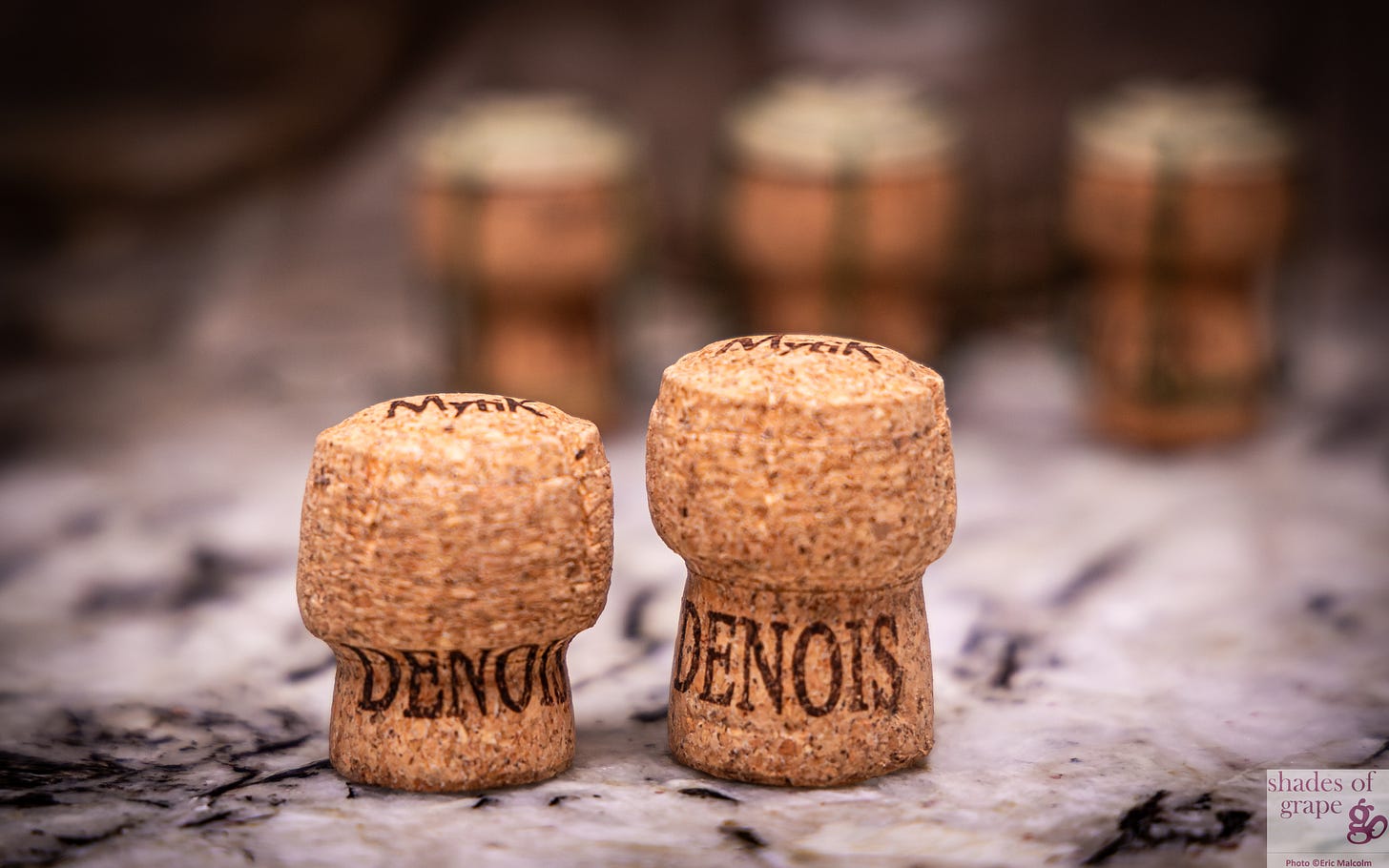
This means there was very little of the cork that was in contact with the bottle to keep the cork in the bottle neck.
Did you know that sparkling wine corks do not start that way?
What do you think. (sheesh - I am not the expert in this odd relationship we are in …)
They start as a perfect cylinder. The mushroom shape is a result of the cork being forced into the bottle. You may notice that after being removed from the bottle the “mushroom stem” expands. That is because it now has room to expand. But it will never revert fully back to its cylinder shape. (You know, plastic versus elastic deformation for any geeks out there. Sorry, that’s just my engineering nerd past coming out again…)
The corks seen above are agglomerate cork.
Definition please – sounds bad… is it fake? I assume you do not approve...
Agglomerate corks are composed of ground up natural cork granules ‘glued together’ with a food-grade adhesive to form a cylinder. They function very similarly to regular “intact” natural cork. I approve of its use.
The picture here is what an intact natural cork would look like after being “cored” from a cork tree bark.
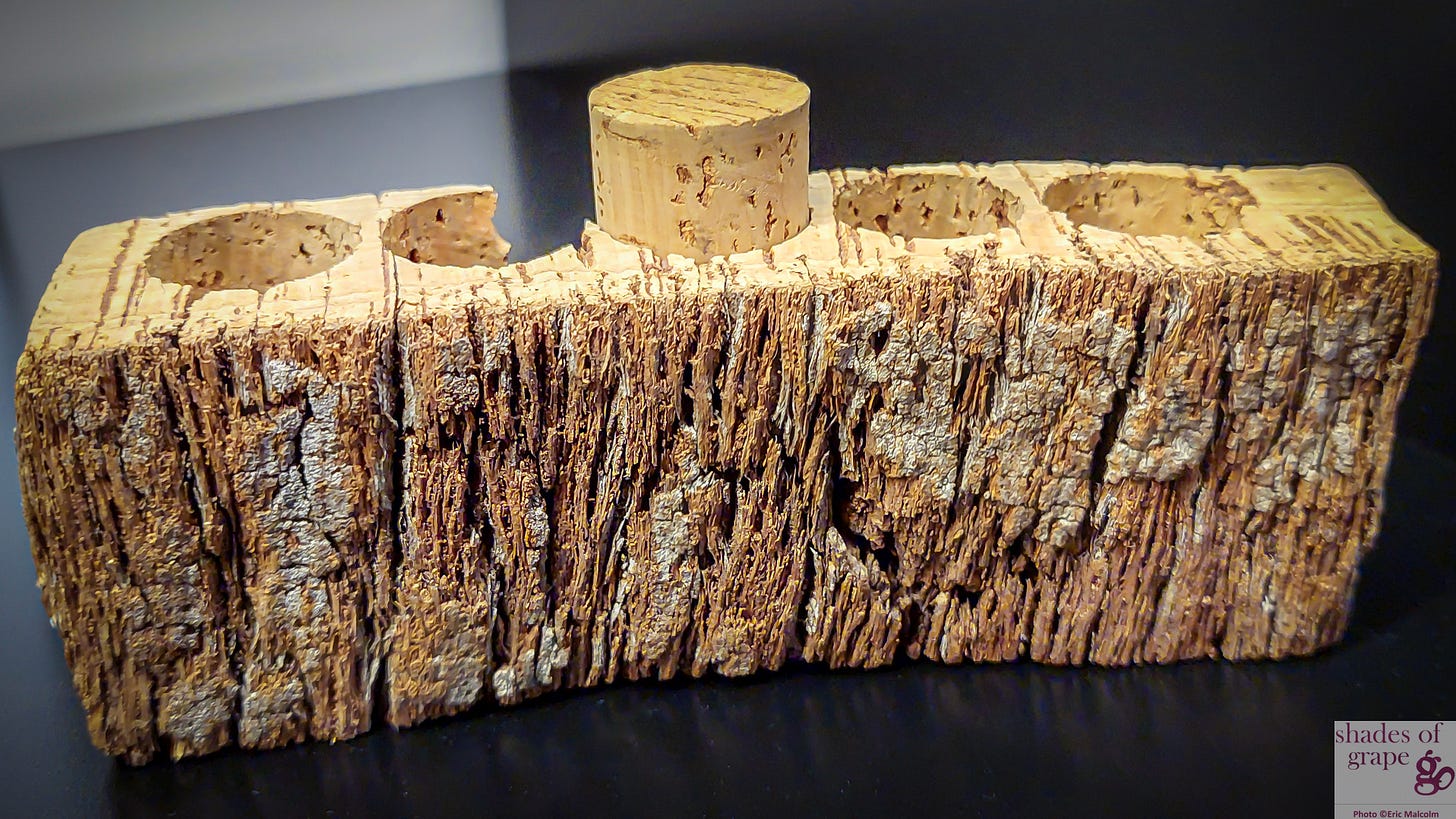
Corks come from a species of Oak called Quercus suber. It has very thick bark that is tough enough to be stripped from the tree’s trunk and larger branches without damaging the tree. The bark/cork grows back in time!
Like shearing sheep!
Did you just come up with that?
However, in the case of cork, you can only strip the tree every 9 years (for Portugal law anyway.) These trees on average survive 170 years, although one cork tree near Lisbon Portugal is approximately 240 years old!
These cork/oak trees like the climate, soils and, elevation of the western Mediterranean, mainly, Portugal, Spain, and Northern Africa. This is from where most cork is grown.
It’s cool that the corks are just punched out of the strips, not what I had pictured. Not that I had even thought of picturing anything, honestly!
Yes, it surprised me too. Can you believe the cork punching is typically done by hand? One of the reasons is that the punch operator can physically examine the cork strip to ensure that the punched cork has minimal defects to eliminate waste. Machines are getting better at doing just that too.
Okay, but I just put something together. The sparkling wine cork cylinder you have pictured looks too thick to come from the bark!
Very observant! Sparkling wine cylinders are 31 mm in diameter and the neck of a bottle is 18-21 mm in diameter. This means the cork is compressed by about 30-40% in diameter. The large initial diameter is used is to ensure a good tight seal. Remember that the cork, along with the cage, is holding 500-600 kPa of pressure.

Okay, I get it, so this is the reason for the agglomerate cork as mentioned at the beginning of the article.
Exactly. It is not practical for sparkling wine corks to be made entirely of “intact” natural cork. Some producers will use discs of natural cork at the base of the “mushroom stem” as this is what is in contact with the wine itself. Check out the pictures just above and below.
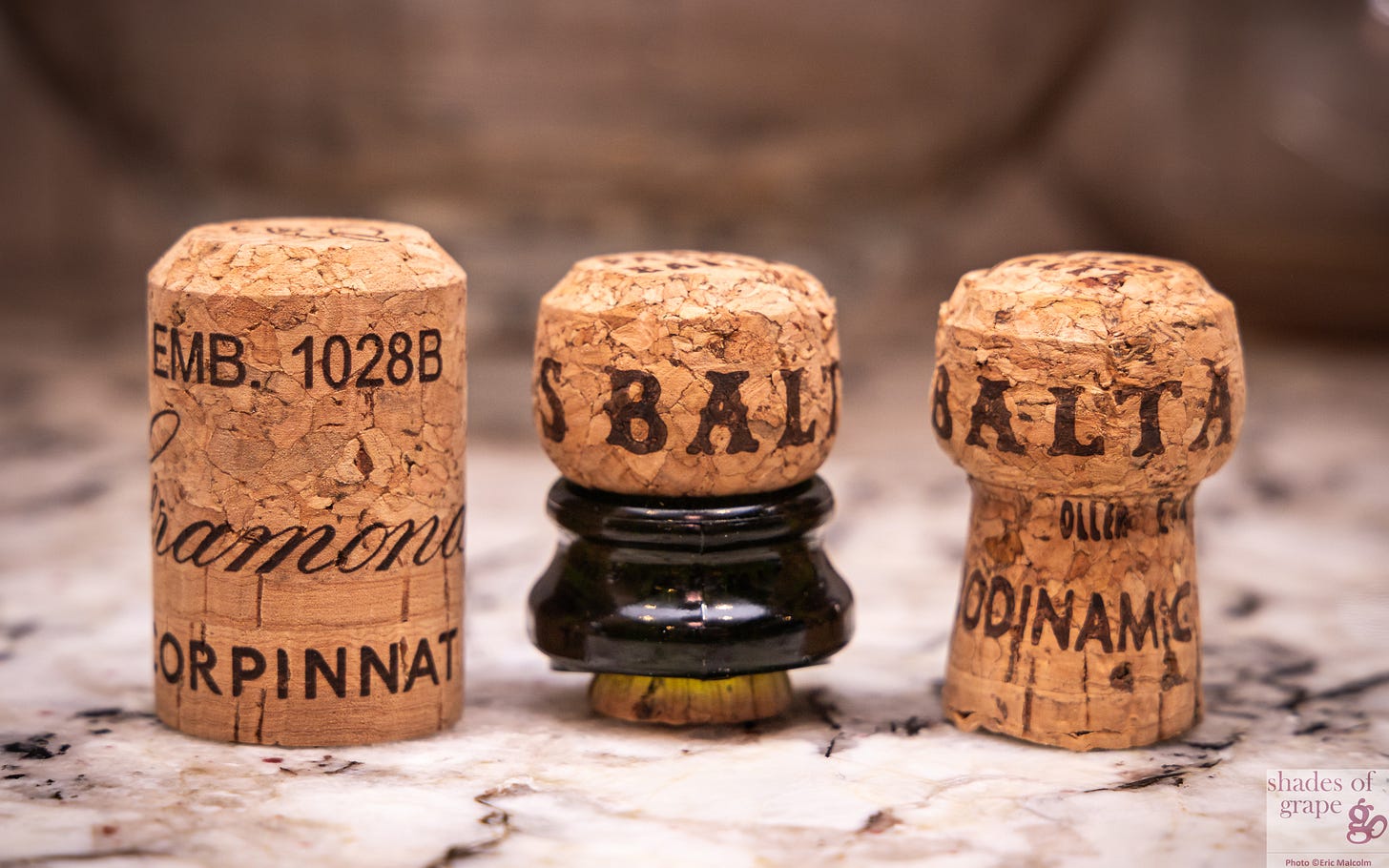
Lastly, before I sign off and discuss the really delicious featured sparkling wine from Loire, made with Chenin Blanc, I need to tell you a story.
Wow … you never start a new story at this stage.
Well, that is because it was unexpected and very à propos of this new series of mishaps.
I wanted to feature this Chenin sparkling wine from the Loire Valley, but the wine did not arrive until today. I brought it home from Cork store ….
You said CORK! … Very à propos …
(eye roll)
And since I walked home, the wine got shaken up not to mention I didn’t have much time to let it cool prior to opening. I was too lazy to create an ice bath (which only takes about 25 minutes to fully cool a sparkling wine.…) but since I had already written my draft above, I was being extra safety conscious. I left the cage on, I used a tea towel … and whoop, the cork released, there was foam, and some wine spilled.
How dreadful, how wasteful!
Dreadfully wasteful! But all that to say it was delicious! I could write a whole post about this wine. But who knew …
For another time ….
Never a shortage of stories! In the meantime …
Cork it up!
Enjoying my recommendations? Consider upgrading to a paid subscription.
Champalou Vouvray Brut from Vouvray, Loire Valley, France
Style: Traditional Method Sparkling Wine
Varieties: Chenin Blanc
This is a crisp, lively, tart wine with a contradictory, yet balancing richness. It is complex with flavors of pear, green apple, caramel apple, lemon, lime, and cream. It has a lot freshness (aka acidity), moderate intensity, and a very persistent finish.
Best pairings: Oysters, Sushi, Ceviche, Smoked salmon, Roasted chicken with a citrus glaze, Pork tenderloin with apple or mustard sauce, Arugula salad with pear goat cheese, and pecans, Quiche, Soft cheese: Brie or Semi-soft goat, AND oh … surprisingly … Grilled jerk chicken thighs! (yes that was dinner.)
Serving Temperature: 4 - 6 degrees Celsius
Serving Tips: Enjoy but be safe!
Price: ~$35 Cdn
If you're in Alberta and want a one-on-one wine curation experience, please reach out! I am also booking private shop appointments. No commitment or minimum purchase required. You will have Calgary’s Cork Fine Wine store in Bow Valley Square to yourself! Interested? Please reach out!
A huge thank you to my paid subscribers—your support helps cover the costs of creating these weekly articles.
Love my wine recommendations? Enjoy my personal wine curation service? If you find value in my writing, consider upgrading to a paid subscription to help me keep sharing the world of wine with you!
I have compiled all my wine recommendations in one place. I will do my best to keep this up to date. I also include the link(s) to the article in which the wine was featured.
Like what you are reading? Click on the ❤ to let me know it resonated with you!
SOURCES:
Harding, J. and Robinson, J. (2023) The oxford companion to wine. Oxford, United Kingdom: Oxford University Press.
MacNeil, K. (2022) The wine bible. New York, NY: Workman Publishing.
Winemakers in Vouvray. Champalou. (n.d.). https://champalou.com/en/
Wine & Spirit Education Trust (2021) D3: Wines of the World - An accompaniment to the WSET Level 4 Diploma in Wines. Version 1.2. London: Wine & Spirit Education Trust.



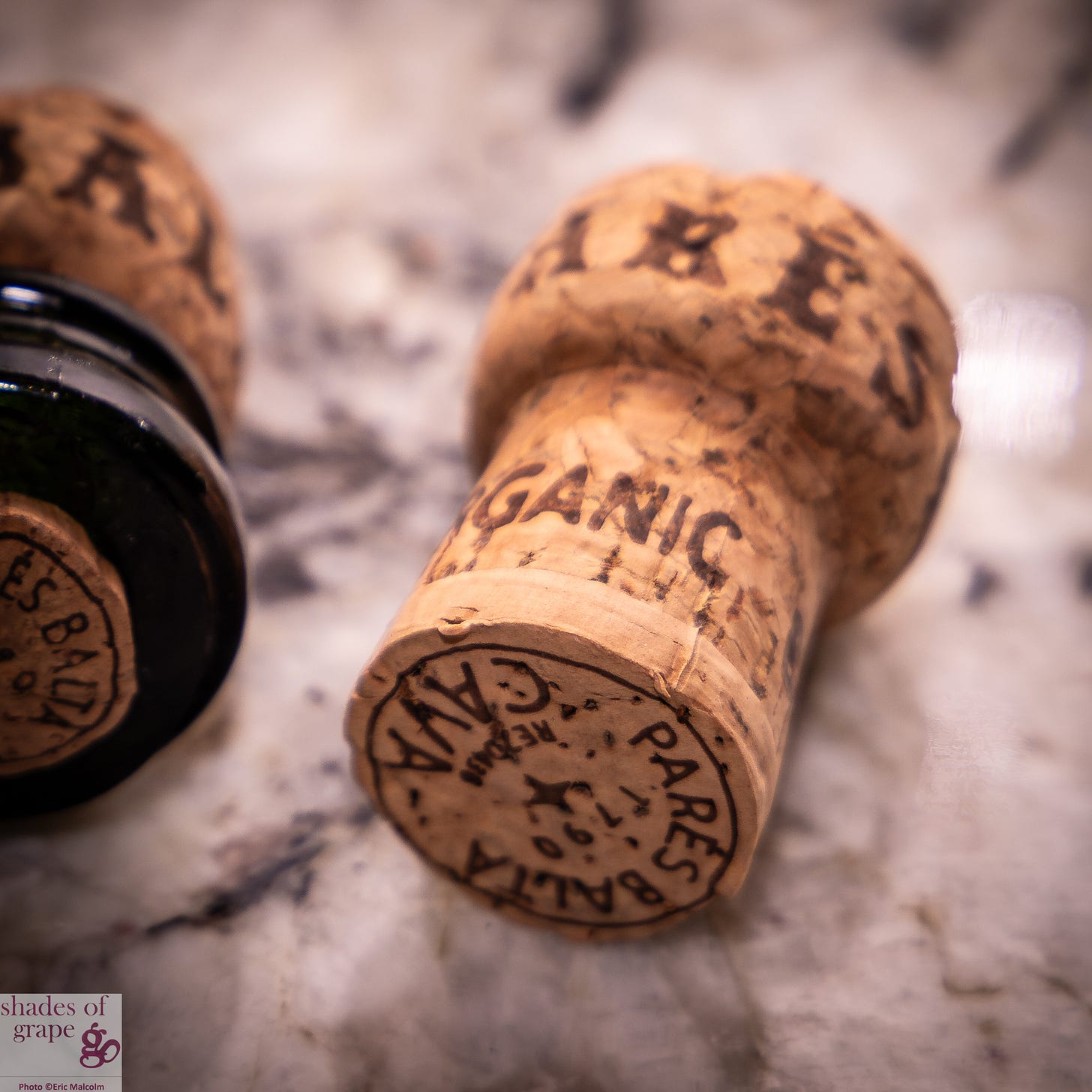
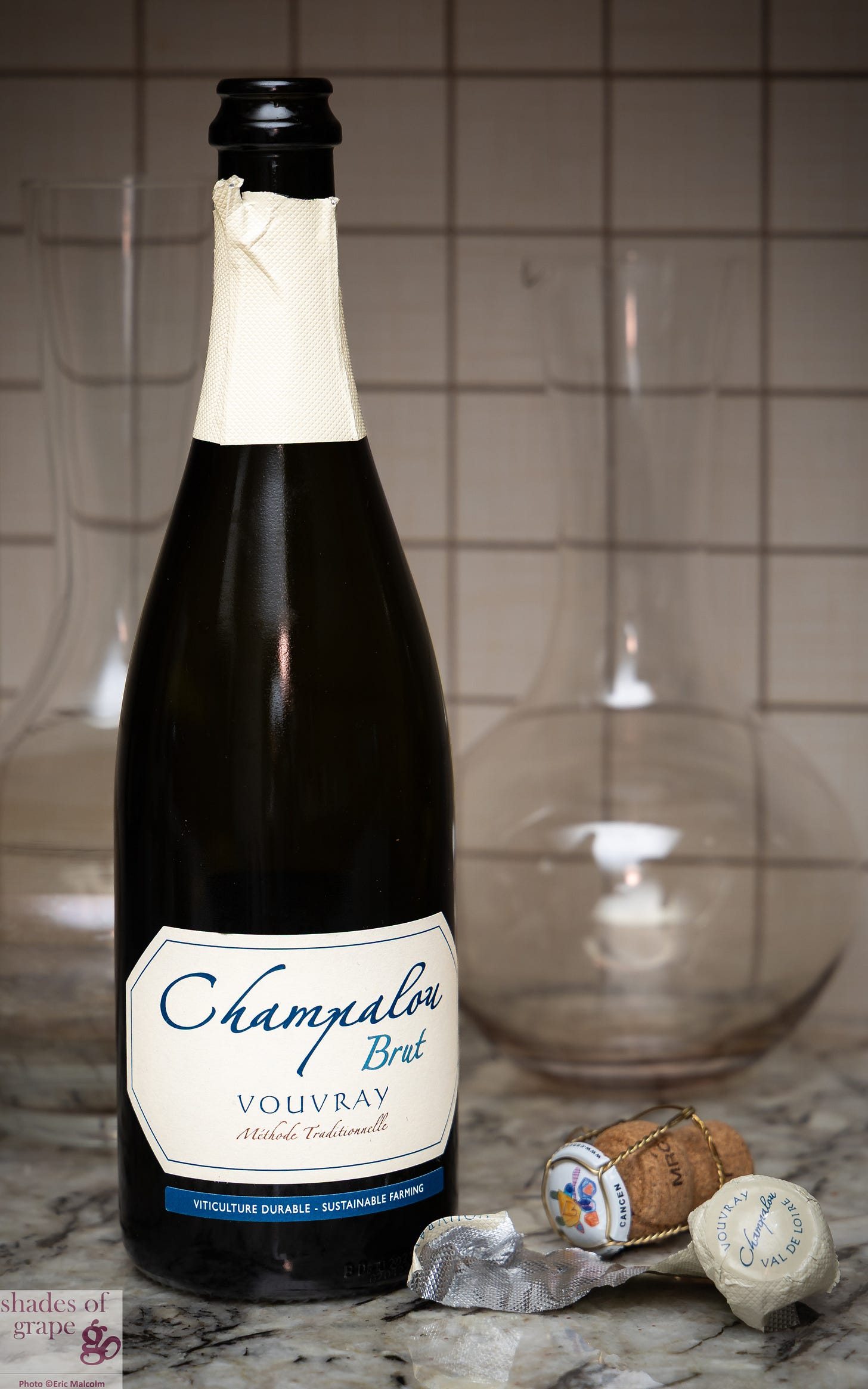

Love it when the engineer in you shines. Super interesting on the cork making!! I feel like we should keep every cork given what I have just read :)